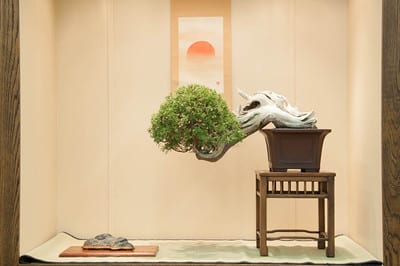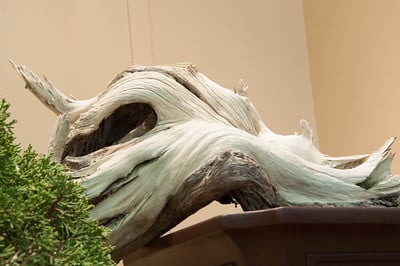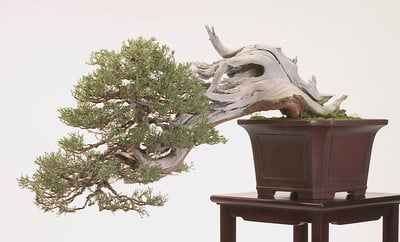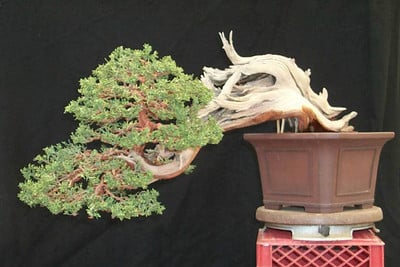One of the trees at Yamato’s recent exhibit was familiar to me. I’d seen it, a sierra juniper, developed since the early 2000s and displayed along the way at local shows. While I don’t have a great photo history of the tree, I do have a couple of shots from a few years back to offer an idea of how the tree has changed over time.

Sierra juniper

As displayed at Yamato’s 42nd annual exhibit

Deadwood detail

As displayed at Bay Island Bonsai’s 5th exhibit in 2004

After restyling – circa 2003
Subscribe to Bonsai Tonight
New Posts Delivered Every Tuesday and Friday
redtearsblackwings says
I like the way that the green is perched right on the end of the dead wood, much like a tree on the side of a woody cliff.
Zack Clayton says
I know this is personal taste showing up, but I think the 2003 and 2004 displays are better bonsai than the the 42nd Yamato display. The older versions look like trees with room for life in the branches. The Yamato version makes me think of a green dumpling on the end of a piece of driftwood – nice topiary. Like I said – personal preference.
Merilee says
I have to agree with Zack. I like the older versions better! But that’s me.
Trinity Rivers says
Wow that’s incredible. Thanks for sharing.
Brian McGrath says
I agree that it’s 2003
Qualicum Brian
M. Daniele says
They ruined the tree. Looks like a deadwood topiary now
Chis says
Retro (’03 & ’04) is much better. Now it looks like a lime flavored lollipop.
M Murtaugh says
Jonas,
Thanks for the opportunity to see the same tree some 10 years apart. Some things change and some things don’t. A tree can stay about the same for a long time, which can be good! A couple thoughts here.
1) The tree is in great health. It seems even more green than it was in ’04. If you can keep a tree alive and healthy for that long you are doing something right.
2) The earlier styling had 2 foliage areas, a top and a lower left branch. This seems to have been lost in those years.
3) It is a Sierra juniper, which has a lighter, more open type of growth pattern than Japanese juniper species. I feel, the openness and airiness should still be kept in the feeling of the potted tree.
4) With the growth and vigor that is on this tree it could easily be taken to a older club member or local professional (and I know there are those around Yamato club-land) for a wiring and re-style. The foliage could be adjusted into several pieces and opened up to show more branch movement. Within a year it would be a show piece again.
5) Did anyone else notice the tree had been replanted from a corner, to the side, in the same pot? Which is better?
6) And last, what is the mention of Johnny’s juniper? Is there more history we might know about?
Thanks as always. MM
Jonas Dupuich says
Thanks for the note, Michael, well said. I might have known more about the tree’s history at one point, but if so, I’ve forgotten it – I’d be happy to hear it if there is more to the story! The main reason I focused on the tree is because the deadwood is great – that and I find it interesting to see trees change over time.
Don Quixote says
Have we not learned anything from Ryan Neil? We are drawn to things that are alive. The foliage is what draws our attention. We use the foliage to guide the eye because it’s the color of the foliage, not the dead wood that draws our attention. By bringing the foliage closer to an area that is not as valuable, this will increase and not lessen the distraction of that area. That’s why we like the original pics because the foliage is closer to the trunk and not separated like the lolli at the end of a stick.